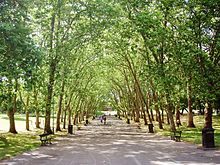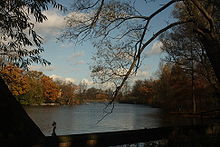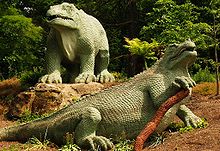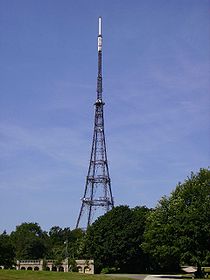- Crystal Palace, London
-
For other uses, see Crystal Palace (disambiguation).
Coordinates: 51°25′13″N 0°04′14″W / 51.4203°N 0.0705°W
Crystal Palace 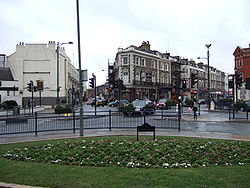
View of Crystal Palace from the park. Four London Boroughs; Bromley, Croydon, Lambeth, and Lewisham meet at this junction. A fifth, Southwark, is only 0.6 km away.
 Crystal Palace shown within Greater London
Crystal Palace shown within Greater LondonOS grid reference TQ341708 London borough Bromley Croydon Lambeth Southwark Lewisham Ceremonial county Greater London Region London Country England Sovereign state United Kingdom Post town LONDON Postcode district SE19, SE20, SE26 Dialling code 020 Police Metropolitan Fire London Ambulance London EU Parliament London UK Parliament Beckenham Croydon North Dulwich and West Norwood Lewisham West and Penge London Assembly Bexley and Bromley Croydon and Sutton Lambeth and Southwark List of places: UK • England • London Crystal Palace is a residential area in south London, England named from the former local landmark, The Crystal Palace,[1] which occupied the area from 1854 to 1936. The area is located approximately 8 miles south east of Charing Cross, and offers impressive views over the capital. An electoral ward named Crystal Palace and Crystal Palace Park are entirely contained within the London Borough of Bromley. However, the wider area has no defined boundaries and straddles the convergence of five London boroughs and three postal districts. It is contiguous with Anerley, Dulwich Wood, Gipsy Hill, Penge, South Norwood, Sydenham and Upper Norwood. It includes one of the highest points in London, 367 feet (112 m) at OS map reference TQ337707.[2] Two television transmitter masts make the district a landmark location, visible from many parts of the London area.
Contents
History
The ridge and the historic oak tree known as The Vicars Oak (located at the present-day crossroads of the A212 Church Road and A214 Westow Hill) were used to mark parish boundaries. This has led to the Crystal Palace area straddling the boundaries of five London Boroughs; Bromley, Croydon, Lambeth, Southwark and Lewisham. The area also straddles at least three postcode districts SE19 , SE20 , and SE26 . The ancient boundary between Surrey and Kent passes through the area and from 1889 to 1965 the area lay on the south eastern boundary of the County of London. It included parts of Kent and Surrey until 1889 and then parts of Kent, London and Surrey between 1889-1965.
For centuries the area was occupied by the Great North Wood, an extensive area of natural oak forest that formed a wilderness close to the southern edge of the ever-expanding city of London. Local legend has it that Sir Francis Drake's ship, the Golden Hind, had its timbers cut from trees in this area. The forest was a popular area for Londoners' recreation right up to the 19th century, when it began to be built over. It was also a haunt of Gypsies, with many local street names and pubs recording the link. The area still retains vestiges of woodland. The third quarter of the 19th Century brought the Crystal Palace and the railways.
The Crystal Palace
The Crystal Palace was a cast-iron and glass building originally erected in Hyde Park to house the Great Exhibition of 1851. Following the success of the exhibition, the palace was moved and reconstructed in 1854 in a modified and enlarged form in the grounds of the Penge Place estate at Sydenham Hill. It attracted visitors for over seven decades.[3]
Sydenham Hill is one of the highest locations in London; 109 metres (357 ft) above sea level (spot height on Ordnance Survey Map); and the size of the palace and prominence of the site made it easy to identify from much of London. This led to the residential area around the building becoming known as Crystal Palace instead of Sydenham Hill. The palace was destroyed by fire on 30 November 1936 and the site of the building and its grounds is now known as Crystal Palace Park.
Area today
Crystal Palace still retains much of its impressive Victorian architecture, although housing styles are mixed, with Victorian terraces next to mid-war terraces side by side with blocks of modern flats. Crystal Palace Park is surrounded by grand Victorian villas, many of which have been converted into flats and apartments.
The "Crystal Palace Triangle", formed by Westow Street, Westow Hill and Church Road, has a large number of restaurants and several independent shops, as well as a sprawling indoor secondhand market on Haynes Lane.
In 2011, parts of the Italian Terrace is falling into ruin. Some of the balcony has fallen off and a number of sculptures are damaged.The Information Desk is running a petition for Crystal Palace Park to have a sensory garden. Some of the dinosaurs show cracks.
Crystal Palace Park
Crystal Palace Park is a Victorian pleasure ground used for many cultural, patriotic and sporting events. The sculptor Benjamin Waterhouse Hawkins erected the first lifesized models of the (then) newly-discovered dinosaurs and other extinct animals in the park, following the gift of a megatherium skull by Charles Darwin.[citation needed] The grounds once housed a football ground, which hosted the FA Cup final from 1895 to 1914 as well as London County Cricket Club games from 1900 to 1908, when they folded, and Crystal Palace F.C.'s matches from their formation in 1905 until the club was forced to relocate during the First World War.
This site is now the National Sports Centre, built in 1964. In 2005 the Mayor of London and the London Development Agency (LDA) took control of the NSC as part of London's bid for the 2012 Summer Olympics and Paralympics, and it is now managed by Greenwich Leisure on their behalf. In January 2011 the owners of Crystal Palace F.C. announced plans to relocate the club back to the site of the NSC from their current Selhurst Park home, redeveloping it into a 25,000-seater, purpose-built football stadium.[4] However Tottenham Hotspur F.C. have also released plans to redevelop the NSC into a 25,000-seater stadium, maintaining it as an athletics stadium, as part of their plans to redevelop the Olympic Stadium after the 2012 Summer Olympics and Paralympics.[5]
The extensive grounds were used in pre-war days for motorcycle and, after the 1950s, for motorcar racing; this was known as the Crystal Palace circuit. Parts of the track layout remain in 2005 as access roads. The track itself fell into disuse after 1972, although it has been digitally recreated in the Grand Prix Legends racing simulation and 2010 sees the 10 years of campaigning work to reopen the track culminating in The return of Motor racing to Crystal Palace
The park also housed one of the pioneer speedway tracks, opening for business in 1928. The Glaziers raced in the Southern and National Leagues up to 1933 when the promotion moved on to a track in New Cross.
The park remains a major London public park. The park was maintained by the LCC and later the GLC, but with the abolition of the GLC in 1986 control of the park was given to the London Borough of Bromley. The park is entirely within the London Borough of Bromley, but its proximity to other boroughs left many Crystal Palace residents[who?] of surrounding boroughs feeling disenfranchised.
A long-fought-over local issue is whether to build on the open space which was the location of the original Crystal Palace building or to leave it as parkland as the GLC had done. Any development would be within the London Borough of Bromley, but affect residents in neighbouring boroughs and the access to the NSC. It would also affect the skyline view across the whole of London.
The park is situated half way along the Norwood Ridge at one of its highest points. This ridge offers views northward to central London, east to the Queen Elizabeth II Bridge and Greenwich, and southward to Croydon and the North Downs. The park has recently[when?] become home to many ring-necked parakeets, especially in the trees around the café and play area. Sightings of the birds have become increasingly common in South London but rarely in a location as busy as Crystal Palace Park. The park is one of the starting points for the Green Chain Walk, linking to places such as Chislehurst, Erith, the Thames Barrier and Thamesmead. Section 3 of the Capital Ring walk round London goes through the park.[6]
Media
Television
Two TV transmitter towers — Crystal Palace Transmitter (640 ft) and Croydon Transmitter (500 ft) — stand on the hill at Upper Norwood, making the district a landmark location, visible from many parts of the London area. The towers may appear similar in height and design, but the Crystal Palace mast, constructed 1956, stands on a slightly higher elevation. The current Croydon tower was built in 1962.
Films
The Italian Job has a scene filmed by the athletics track, in which Michael Caine says "You were only supposed to blow the bloody doors off!"[citation needed]
The Pleasure Garden was also filmed in the park.[citation needed]
Our Mother's House has a scene featuring Dirk Bogarde with several children on the boating lake in Crystal Palace Park.
Music
The park features prominently as the setting of an outdoor rave in the music video for The Chemical Brothers' number 1 single Setting Sun.
A mini-album about the history of the local area, entitled Fire & Glass: A Norwood Tragedy, was released in Spring 2007 by the Anglo-Dutch group, H.E.R.R..[7]
Literature
Arthur Conan Doyle was active in the area between 1891 and 1894. Although he lived in nearby South Norwood he visited the Crystal Palace and Upper Norwood area regularly in connection with the Upper Norwood Literary and Scientific Society. The Forresters Hall on Westow Street was known as the Welcome Hall (or just Welcome) in those days and it was in that hall in May 1892 that Arthur Conan Doyle was elected president of the society. He was re-elected to the post in 1893 and resigned in 1894. Each occasion was in the same hall.[8]
Other
Troy Southgate, author, musician and activist was born and bred in the area, living on Gipsy Hill and the Central Hill Estate. He also attended the local Rockmount School.[citation needed]
Sports teams
- Crystal Palace F.C. (association football)
- London Olympians (American football)
Transport
Roads
The area is served by the A212, A214, A234 and A2199 roads.
Rail
Crystal Palace is accessible by rail via Crystal Palace railway station, where Southern trains run to and from Victoria and London Bridge railway stations. Crystal Palace railway station is one of the few stations to border two zones, Zones 3 and 4.
As of May 2010, the station also serves the East London Line branch of the London Overground, connecting with the Docklands and Shoreditch and in 2011 extended services to Highbury and Islington.
The South Gate of the Park is accessible by rail via Penge West by Southern trains from London Bridge. This station also serves the East London Line branch of the London Overground
There are renewed hopes that the Croydon tramlink to Crystal Palace will eventually find funding and open in a few years.[9][10]
Bus
The area is also well served by bus routes being the terminus for many of them. These services include routes N2, 3/N3, N63, 122, N137, 157, 202, 227, 249, 322, 358, 363, 410, 417, 432, 450, 931 and 934
Nearest places
References
Notes
- ^ Mills, A., Oxford Dictionary of London Place Names, (2000)
- ^ Spot Height in feet, TQ337707, Ordnance Survey Map, 1862
- ^ ric.edu Russell Potter, The Crystal Palace, January 29, 2007. Retrieved 12 October 2008.
- ^ http://www.cpfc.co.uk/page/News/0,,10323~2271669,00.html
- ^ http://www.goal.com/en-gb/news/2896/premier-league/2011/01/28/2327743/tottenham-release-images-of-proposed-crystal-palace
- ^ Walk London, Capital Ring, Section 3, Grove Park to Crystal Palace
- ^ HeathenHarvest Music reviews Luminatrix, H.E.R.R. - Fire And Glass: A Norwood Tragedy, 1 December 2007. Retrieved 12 October 2008.
- ^ The Norwood Author - Arthur Conan Doyle & The Norwood Years (1891-1894) by Alistair Duncan ISBN 978-1904312697
- ^ Streatham Guardian
- ^ http://www.thisislocallondon.co.uk/news/8362902.Ken_Livingstone_looks_to_China_to_regenerate_Croydon/
Bibliography
- Alan R. Warwick The Phoenix Suburb: A South London Social History; Publisher: Crystal Palace Foundation; ISBN 0-904034-01-1
External links
- South London Press article - 'Fight over Crystal Palace Park'
- "Television for Millions" Popular Mechanics, September 1935
- TV Commercial Production Company Crystal Palace London
- Upper Norwood Library for Local History Collection
- Crystal Palace Park
- Map of Crystal Palace Park
- Crystal Palace and Norwood Chamber of Commerce
- The Norwood Society, London's oldest local amenity group
- Virtual Norwood - community web site with photos and online forum
- Historical images of Crystal Palace
- Crystal palace Local forum directory & news
London Borough of Bromley Districts Anerley · Beckenham · Bickley · Biggin Hill · Bromley · Bromley Common · Chislehurst · Downe · Elmstead · Farnborough · Hayes · Keston · Leaves Green · Mottingham · Orpington · Penge · Petts Wood · Pratt's Bottom · Shortlands · Southborough · St Mary Cray · St Paul's Cray · West Wickham
Attractions Bromley Museum · Chislehurst Caves · Churchill Theatre · Crofton Roman Villa · Crystal Palace · Down House · Betts ParkConstituencies Other topics London Borough of Lambeth Districts Brixton · Clapham · Crystal Palace · Gipsy Hill · Herne Hill · Kennington · Lambeth · Oval · Stockwell · Streatham · Streatham Hill · Tulse Hill · Vauxhall · Waterloo · West Dulwich · West Norwood
Attractions Imperial War Museum · Lambeth Archives · Lambeth Palace · London Eye · Lower Marsh Market · Oval Cricket Ground · Southbank Centre (Royal National Theatre • BFI Southbank • Royal Festival Hall • Queen Elizabeth Hall • Purcell Room • Hayward)Bridges Parks and open spaces Constituencies Other topics People · Public art · SchoolsLondon Borough of Southwark Districts Bankside · Bermondsey · Borough/Southwark · Camberwell · Crystal Palace · Dulwich · East Dulwich · Elephant and Castle · Herne Hill · Nunhead · Peckham · Rotherhithe · Surrey Quays · Sydenham Hill · Walworth
Attractions Markets Bridges Constituencies Other topics List of places in London Major districts Abbey Wood · Acton · Barking · Barnes · Barnet · Barnsbury · Battersea · Beckenham · Bermondsey · Bethnal Green · Bexleyheath · Bloomsbury · Bow · Brentford · Brixton · Brockley · Bromley · Camberwell · Camden Town · Canonbury · Carshalton · Catford · Charlton · Chelsea · Chessington · Chingford · Chislehurst · Chiswick · City · Clapham · Clerkenwell · Cricklewood · Coulsdon · Croydon · Dagenham · Deptford · Ealing · East Ham · Edmonton · Eltham · Enfield Town · Erith · Feltham · Finchley · Forest Hill · Forest Gate · Fulham · Greenwich · Hackney · Hammersmith · Hampstead · Harrow · Hendon · Highams Park · Highbury · Highgate · Hillingdon · Holborn · Hook · Holloway · Hornchurch · Hounslow · Ilford · Isle of Dogs · Isleworth · Islington · Kensington · Kentish Town · Kensal Green · Kilburn · Kingston upon Thames · Lambeth · Lewisham · Leyton · Marylebone · Mayfair · Mitcham · Morden · Muswell Hill · New Cross · New Malden · Orpington · Paddington · Peckham · Penge · Pinner · Poplar · Purley · Putney · Richmond · Romford · Ruislip · Shepherd's Bush · Shoreditch · Sidcup · Soho · Southall · Southgate · South Norwood · Southwark · Stepney · Stoke Newington · Stratford · Streatham · Surbiton · Sutton · Sydenham · Teddington · Thamesmead · Tolworth · Tooting · Tottenham · Twickenham · Upminster · Upper Clapton · Uxbridge · Walthamstow · Wandsworth · Wanstead · Wapping · Wealdstone · Welling · Wembley · West Ham · Westminster · West Norwood · Whitechapel · Willesden · Wimbledon · Wood Green · Woodford · Woolwich
Barking and Dagenham · Barnet · Bexley · Brent · Bromley · Camden · Croydon · Ealing · Enfield · Greenwich · Hackney · Hammersmith and Fulham · Haringey · Harrow · Havering · Hillingdon · Hounslow · Islington · Kensington and Chelsea · Kingston · Lambeth · Lewisham · Merton · Newham · Redbridge · Richmond · Southwark · Sutton · Tower Hamlets · Waltham Forest · Wandsworth · Westminster
Section 3: Capital Ring Walking Route Section 4: Grove Park Crystal Palace Streatham Categories:- Districts of London
- Districts of Croydon
- Districts of Bromley
- Districts of Lewisham
- Districts of Southwark
- Districts of Lambeth
- Parks and open spaces in Bromley
- Capital Ring
Wikimedia Foundation. 2010.


